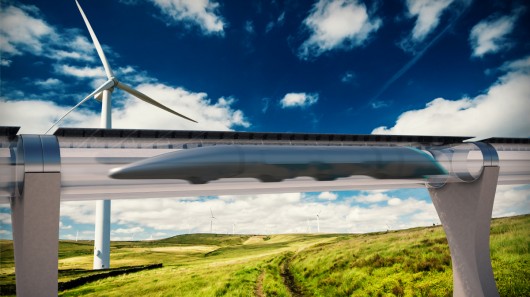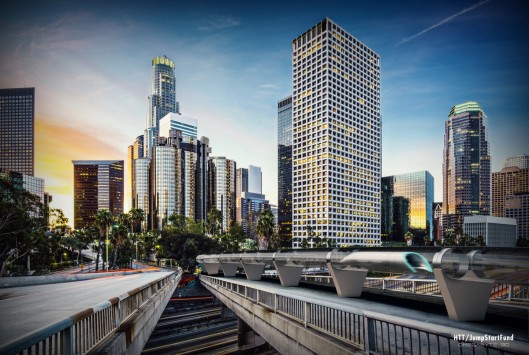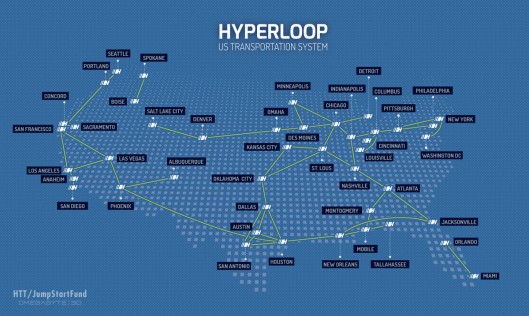Elon Musk’s Hyperloop takes a step closer to reality
February 12, 2015
It seemed like a pipe dream when floated in 2013 by Tesla and SpaceX founder/CEO Elon Musk, but the Hyperloop concept is making tangible progress, though it is still a long way off taking passengers. A startup company called Hyperloop Technologies has been established, with US$8.5 million raised and another $80 million in funds projected for later this year. Meanwhile, another startup called Hyperloop Transportation Technologies (HTT), formed in 2013, has crowdfunded and crowdsourced its way to a team of 170 mostly part-time engineers and designers.
While the work of the two companies is still on paper, or in the bank, actual physical construction may be coming from Musk himself, who last month pledged to build a test track in Texas for groups to work on Hyperloop prototypes. It would mark Musk’s first foray back into the futuristic travel system since releasing a 57-page white paper detailing the Hyperloop concept in August of 2013. Soon after that event, he and his Tesla and SpaceX engineers who helped create the paper, turned their attention back to making cars and building rockets.
But picking up the Hyperloop baton was Dirk Ahlborn, an entrepreneur who had just launched his crowdfunding site JumpStartFund, forming HTT soon after, in part to bring attention to his site. HTT has slowly built up a global team of employees working for equity, with moonlighters from companies like Boeing, Airbus and NASA.
The group’s effort has so far resulted in the creation of a 76-page crowdstorming document that details its own plans for the Hyperloop system. From optimal routes, station types, capsule aerodynamics and seating arrangements, to propulsion, safety, and cost, the document covers nearly all the bases for such a fantastical system. HTT delves deeper than Musk’s original white paper, which Ahlborn told Gizmag was “only a top level design. Many parts like the capsule geometry, etc, had to be revised."
Among the ways HTT’s document departs from Musk’s includes routes other than the originally proposed 30-minute, 380-mile (610-km) ride from San Francisco to Los Angeles. This is because rights-of-way issues for both cities would push stations as far as an hour away from their centers, while a path as straight and level as possible on land not prone to earthquakes would reduce safety issues and g-force induced nausea.
A group of UCLA students from the school’s Sprastudio design and architecture program is collaborating with HTT and working on potential routes (as well as station and pod design) that optimize speed and comfort. Using an algorithm that accounts for geography, buildings and roads, the group has mapped potential routes throughout the US. The Los Angeles to Las Vegas route stands out, while Ahlborn is not averse to exploring the possibility of systems in Europe or Asia. Another option are proposed mini-Hyperloops, for shorter routes into and around cities.
Looking ahead, Ahlborn says, "we have outlined the technology and are quantifying the needed capital to build the prototype." But taking the project from concept to physical is more than lining up billion dollar investors for the conservative estimate of $45.3 million per mile of track needed. HTT’s report acknowledges that, “For sure one of the most challenging areas, the team is still uncertain about the best way to create prototypes that allows to test all necessary components.”
But the fact that other players are entering the fray is an encouraging sign for the future of the Hyperloop. Especially one as well-backed as Hyperloop Technologies, which includes Peter Diamandis, founder of the X-prize, Brogan BamBrogan, a key engineer at SpaceX, and Joe Messina, former White House deputy chief of staff. Instead of passengers, the company has chosen to initially focus on transporting cargo at near supersonic speeds.
Despite Musk’s lack of ongoing involvement with the Hyperloop, his name alone lends enormous cache to the fanciful concept. And his Texas test track would be another boon to the fledgling industry. “It eventually reduces the needed capital amount that we need to raise for the prototype,” Ahlborn says, in reference to the track. “We are excited about him supporting the community that has formed to make his idea reality.”
copyright © Gizmag 2003 - 2015


